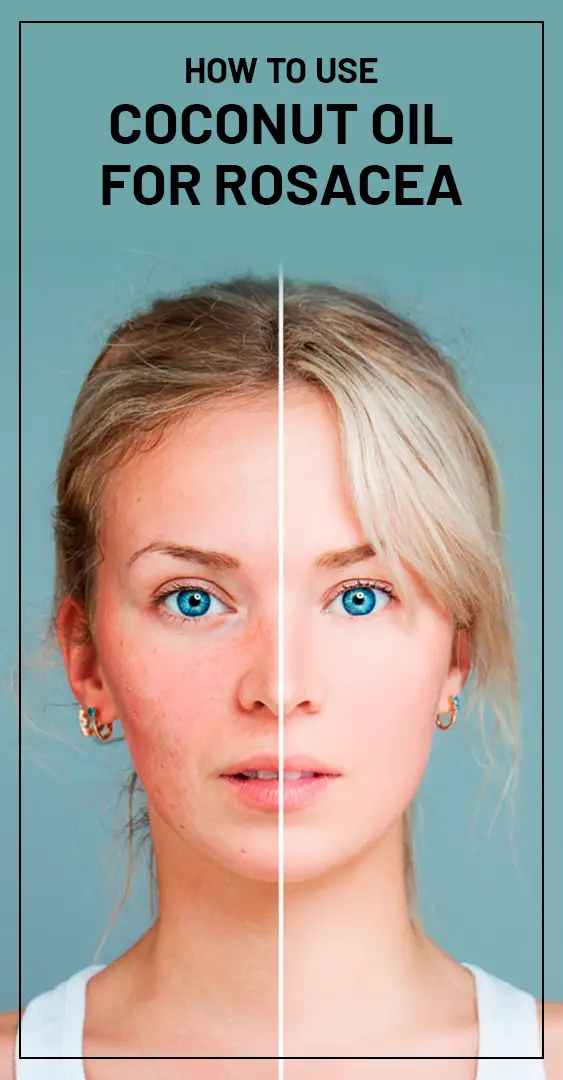
Important: This article is for informational purposes only. Please read our full disclaimer for more details.
There are multiple reasons why coconut oil is lauded as beneficial for the skin. Enriched with fatty acids and a variety of minerals, it is good for everything related to skin. No wonder it helps with a skin condition Rosacea too.
Even though there is no direct research indicating the benefits of coconut oil for Rosacea, some evidence shows how its major components can help significantly. The limited anecdotal evidence supports using coconut oil as a home remedy to treat Rosacea.
Here, we have composed a detailed guide on how coconut oil can help with the symptoms of Rosacea. Before checking them, let’s learn more about this awful skin condition and how it impairs skin.
What Is Rosacea?

Rosacea is a chronic relapsing inflammatory skin condition that occurs on the face- around the cheeks, nose, and forehead. It is prevalent among adults of Northern European heritage with fair skin.
The appearance of small pimples and pustules along with red and dilated blood vessels are the common symptoms of Rosacea. The affected areas feel hot and sensitive.
Use Of Coconut Oil For Rosacea
One of the most effective ways of managing Rosacea is keeping the skin moisturized. With its ultra-hydrating properties, Coconut oil is a good choice to kick out the symptoms.
How does it work?
A few properties of coconut oil that make it effective for Rosacea are-
1- Anti-inflammatory Properties- Coconut oil is composed of medium chain fatty acids, among which lauric acid, capric acid, and caprylic acid are the majority. These acids have anti-inflammatory and skin barrier repair properties.
2. Hydrating Properties- Coconut oil is heavy and thick. It helps the skin retain more water, ensuring it stays hydrated most of the time.
3- Antioxidants- Coconut oil is a reservoir of antioxidants that can balance the oxidative stress on the skin. Oxidative stress implies a chemical imbalance on the skin caused by air particles that worsen Rosacea.
Although no studies are looking directly at Rosacea and coconut oil, such beneficial properties of coconut oil are likely to be helpful and fight off symptoms of Rosacea. It can significantly reduce redness and flare-ups.
Even though science does show the skin-soothing properties of coconut oil, you can give it a try only after getting a green signal from your doctor.
Can You Trust Coconut Oil Completely?
We have learned enough about the benefits of coconut oil, but is it safe for all skin types? Here are a few reasons why some people would like to avoid it-
Coconut oil is comedogenic– It means coconut oil has the tendency to clog pores and cause breakouts. Therefore, it is not the best choice for everyone, especially those with oily or acne-prone skin.
Coconut oil may cause an allergic reaction– Even though the cases of allergy due to coconut are rare, it has triggered an allergic reaction in some, especially in kids. People susceptible to tree nut allergies should use coconut oil with caution.
Therefore, the best way to check if you are a good candidate to use coconut oil for Rosacea is to check with your dermatologist. Depending upon your skin type and allergy triggers, the doctor will help you decide whether to proceed with coconut oil or not.
How To Use Coconut Oil For Rosacea?
If your doctor has given the green signal and your skin is responding well to coconut oil, it’s time to know the right ways to use it for Rosacea.
First of all, you need to have the right kind of coconut oil, which should preferably be cold-pressed virgin coconut oil. It is made without using any additives and heat treatments and processed in a way that retains the virtue of coconut oil intact.
Do not use refined coconut oil as it consists of chemicals that can worsen the symptoms of Rosacea, causing redness and skin irritation.
Secondly, you must perform a patch test before going further with coconut oil. Rosacea-prone skin is susceptible to irritation. Therefore, a patch test will out rule its side effects on the skin.
Follow the instruction for the patch test-
- Take a few drops of virgin coconut oil and apply them to areas near where you usually get the symptoms.
- Do not apply it directly over the flares.
- Wait at least 72 hours to check how your skin responds to coconut oil.
- If there is a burning or stinging sensation, coconut oil is not good for your skin.
However, if the patch test goes well, use your fingertips to apply virgin coconut oil gently over the affected areas of the face. Coconut oil penetrates deep into the skin, making it well-nourished and deeply hydrated- something that keeps Rosacea symptoms at bay.
Final Words
Coconut oil consists of properties that could help manage Rosacea symptoms to a great extent. Just make sure that you use cold-pressed virgin coconut oil and perform a patch test before slathering it all over the face.
Even though coconut oil proves to be beneficial for Rosacea, it is not the only way to treat this chronic skin condition. It can be used along with other medications recommended by the dermatologist.
Always remember to check with your doctor before using any alternative skin remedy.
You Might Also Like:
- 5 Best Makeup Tips to Cover Rosacea
- Homemade Coconut oil Face Mask
- Tea Tree oil for Rosacea
- How to Use Green Tea for Rosacea
- How to Use Apple Cider Vinegar to Treat Rosacea?
- Difference Between Coconut Oil And Coconut Butter
- 10 Best Tinted Moisturizer For Rosacea
- 7 Best Face Masks For Rosacea
- 14 Surprising Beauty Benefits of Baking Soda You Must Know!
- Coconut Oil For Acid Reflux
- How to Use Coconut Oil for Constipation?
- How to Remove Dandruff With Coconut oil?
- Coconut Oil for Diaper Rash: Does It Work and How to Use?
- Does Coconut oil Help with Scars And How To Use It?
- How to Use Coconut Oil to Remove Your Stretch Marks?
- Difference Between Coconut Oil And Coconut Butter

















